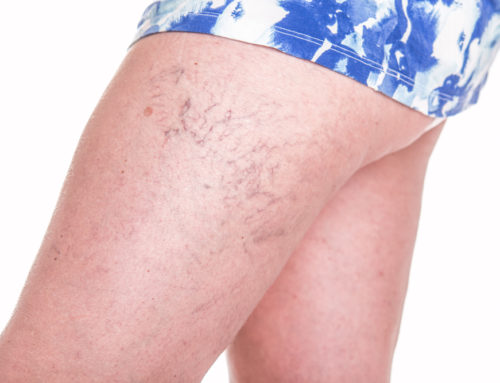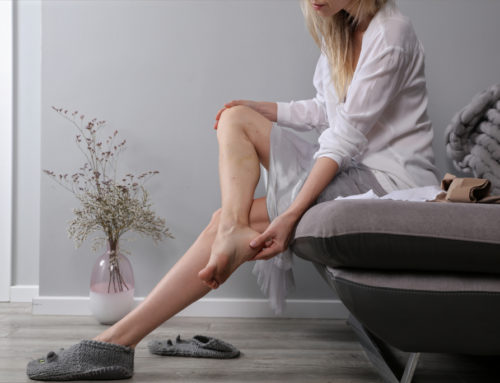Cosmetic tattooing and permanent makeup have definitely been on the rise over the last couple of years. You can now walk into a salon and get a tattoo that alters your lip color or changes your eyebrow shape.
Another popular service that has cropped up recently is the practice of using tattoos to cover up scars and other aesthetic problems. Tattoos can be effective ways to beautifully mask stretch marks and scars. However, tattoos may not be the best way to conceal spider veins and varicose veins.
Tattoo On Veins — Good or Bad?
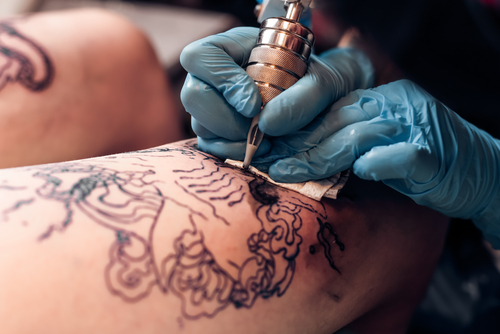
Have you ever seen someone get a large leg tattoo to cover up an unsightly varicose vein? Branches, dark designs, or large multicolored images are all common ways people cover up dark spider veins and bulging varicose veins. However, there are many factors to consider before getting inked, as this may not be safe or effective for concealing the veins.
Curious about the health of your veins? Take our vein health assessment quiz below.
Can You Tattoo Over Spider Veins?
When you get a tattoo, a tattoo artist uses a rotary gun with tattoo-specific needles to inject pigment, or ink, under your epidermis and into your dermis skin layer.
How deep does the tattoo needle go? If done correctly, the needle should go about 1.5 to 2 millimeters under the skin. While not likely, there is a possibility that a tattoo needle could go too far and puncture the hypodermis and rupture a vein. Tattoos typically do not puncture regular veins, but there is a higher risk of encountering more problems with spider veins.
Varicose veins are large, twisted veins that appear rope-like and may be blue or purple in color. These enlarged veins are often symptoms of a venous disease that causes valve malfunctions and abnormal pooling in veins. Although they are not severe most of the time, they can be unsightly.
So, yes, you technically could try to tattoo over a spider vein. Having said that, tattooing over spider and varicose veins is not always recommended for a variety of both health and aesthetic concerns.
Before proceeding, it’s crucial to understand the potential challenges and risks involved. While covering up veins with a tattoo might seem like a quick fix, it’s highly advisable to consult a healthcare professional. Seeking treatment for the underlying condition, such as chronic venous insufficiency, can ensure that your veins won’t interfere with your tattoo and that your overall health is prioritized.
Risks associated with tattooing over spider and varicose veins include:
- Ruptured vein(s) are possible from consistent pressure from the needle on the vein wall
- Infection irritation to the vein wall from the needle can trigger an infection
- Deformed tattoo from the bulging of the vein distorting the image of the tattoo
- Scarring if the needle goes too deep
- Bleeding from the needle hitting the vein walls
Another risk to consider, although unlikely, the vein could potentially rupture.Plus, tattooing over areas without veins is painful and will cause swelling. Tattooing over a sensitive area like a varicose vein will only exacerbate the pain and swelling.
On top of that, the bulging varicose veins may distort the tattoo design, and you may be unhappy with the results.
Aside from the tattoo itself, a vein specialist may have a more difficult time treating varicose veins covered by a tattoo. Treatment is more effective—and safer—when the physician can see the varicose vein clearly.
Can Laser Tattoo Removal Be Performed on a Tattoo Over Varicose Veins?
Yes, it is possible to remove a tattoo with a laser even if it’s located over varicose veins. However, there are important considerations and potential risks involved.
Potential Risks:
- Vein Damage: Lasers used in tattoo removal could inadvertently affect the veins. This could lead to complications, especially if the veins are vulnerable.
- Increased Pain: Due to the presence of varicose veins, the procedure might be more painful than usual. This is because veins can heighten the sensitivity of the area.
- Healing Concerns: Altered circulation in the area might slow down the healing process after the tattoo is removed.
Factors to Consider:
- Tattoo Specifications: The size and position of the tattoo can influence how the removal process is approached.
- Individual Health: Your medical history and overall health are critical in assessing risks. Conditions affecting your skin or veins should be discussed.
- Laser Type and Settings: Different lasers and their settings can impact how safely and effectively the procedure is done over varicose veins.
Consultation Is Key:
Before proceeding, it is crucial to consult a healthcare provider or a tattoo removal specialist. They can analyze your specific situation, weigh the risks, and determine the most appropriate course of action for safe and effective removal. Always seek professional advice tailored to your unique circumstances.
How to Prepare for Tattooing Over Varicose and Spider Veins
Thinking about getting a tattoo over varicose or spider veins? It’s crucial to approach this with care and awareness. Here’s a comprehensive guide on how you can prepare effectively:
1. Consult Medical Professionals
- Seek Advice from Specialists: Before proceeding, book an appointment with a vein specialist or dermatologist. Their expertise can help assess the condition of your veins and ensure that tattooing in the area won’t pose a health risk.
2. Choose the Right Tattoo Artist
- Prioritize Experience: Not all tattoo artists have experience dealing with varicose or spider veins. Opt for one who has a proven track record in working with similar cases. This ensures they know how to handle potential complexities with care.
3. Consider Safer Locations
- Evaluate Placement Options: Areas like the legs are more prone to varicose veins and might not be ideal for tattoo placement. Explore alternative parts of your body that provide a safer canvas for your tattoo.
4. Follow Aftercare Diligently
- Adhere to Aftercare Advice: Proper aftercare is essential to avoid complications such as infection or scarring. Ensure you understand and follow the aftercare instructions provided by your tattoo artist meticulously.
5. Assess Your Health Status
- Ensure Skin Health: Good overall skin health can facilitate better tattooing outcomes, especially in compromised areas like those with varicose veins. Maintain hydration and a healthy skincare routine leading up to your tattoo appointment.
By taking these steps, you can significantly increase the likelihood of a successful tattoo experience, even over areas affected by varicose or spider veins.
Understanding the Healing Process of Tattooing Over Varicose Veins
Tattooing over varicose veins involves unique healing considerations due to altered blood flow in the affected areas. Here’s a comprehensive breakdown of what to expect:
Complications and Risks
- Slower Healing: Varicose veins can disrupt normal blood circulation, potentially leading to a prolonged recovery period.
- Increased Infection Risk: The compromised skin can heighten the possibility of infection, as the body’s ability to fight off pathogens in the area may be reduced.
- Potential for Additional Pain or Bruising: The sensitive nature of the skin over varicose veins may result in increased discomfort compared to other areas.
Essential Aftercare Steps
- Meticulous Hygiene: Keeping the tattoo clean is paramount. Use a gentle, fragrance-free cleanser as instructed by the tattoo artist to avoid irritation.
- Moisturization: Apply recommended tattoo creams or lotions to help keep the area hydrated and promote healing.
- Avoiding Pressure: Steer clear of tight clothing that might press on the tattooed area, further compromising blood flow.
- Observation for Complications: Keep an eye out for signs of infection or unusual swelling and consult a healthcare professional if these occur.
Consulting Professionals
Engage with a skilled tattoo artist who has experience with similar situations. They can provide personalized advice tailored to your health and the specifics of your varicose veins.
By following these guidelines and working closely with professionals, you can better support the healing process and ensure the safety of tattooing over varicose veins.
Reasons Against Tattooing Over Veins
Before getting inked, consider these five of the main reasons why tattooing over spider veins is a bad solution to your vein problem:
1. There is a High Likelihood of More Spider and Varicose Veins Appearing in the Area.
Unfortunately, a patient who begins developing spider or varicose veins is very likely to develop more veins as time goes on. Genetics and gender make some people naturally more predisposed to this condition.
If you decide to get a cover-up tattoo, the artwork may only be a temporary fix. For example, while your new tattoo covers a few inches of spider veins, you are very likely to discover new spider veins popping up around the edges of the artwork in just a few years. Continuously attempting to cover every spider vein would not only be impractical but also costly.
2. The Tattoo Can Make Future Vein Treatment More Difficult.
As with any medical procedure, it is easier to perform if your vein specialist can clearly see the area they need to treat. Tattoos, especially darker-toned ones, cover the exact area your doctor needs to examine.
Leaving the area clean and free of unnecessary obstructions, on the other hand, will make any future treatments a lot easier to perform. Treating spider veins and varicose veins may be vital to preventing blood clots and poor circulation down the road.
From an aesthetic point, tattoos look better on a blank canvas. Dark veins and bulging veins could distort the overall image and lead to disappointment. If you want a tattoo in a specific area that currently has visible dark veins, first seek treatment to create a beautiful blank canvas.
3. It Can be a Health Risk.
Although unlikely, it is still possible for a tattoo to cause further damage to a vein. As with any skin puncturing, a tattoo only increases your risks of infection and other complications.
However, if you do decide to move forward with getting a tattoo, do your due diligence beforehand. Tattooing over blood veins is generally not recommended, as it can lead to complications and discomfort. It’s crucial to consult with a professional tattoo artist and a vein specialist to determine if it’s safe for you to get a tattoo over any blood vessels, particularly if they are diseased.
Find a reputable, clean tattoo parlor, and ask your tattooist about their process. Make sure that all of the tools used are sanitized before each use. Although, a reputable tattoo artist may refuse to cover spider or varicose veins with a tattoo, for any of the reasons discussed here. Prioritizing your health and safety should always come first, and getting multiple expert opinions is a wise approach.
NOTE: DO NOT opt for the cheapest tattoo artist to save a couple hundred dollars. Paying more up front can save you down the road from costly cover-ups or even hospital stays due to infection. Do thorough research on multiple social media platforms and websites before choosing a tattoo artist. Consider travelling to a different city or even out of state to see a well-trained artist who specializes in varicose veins and spider veins.
4. Your Veins Could Mean Something More Serious.
You should always consult with a medical professional before forging ahead with a self-prescribed treatment. The simple truth is that a discolored vein may not always be a simple case of spider veins.
Regardless of the cause of the discoloration, covering it will only make it more difficult to evaluate. Worse, a tattoo can prevent you from noticing any alarming changes to your own veins. At the very least, try to come in for a vein evaluation before you attempt to cover up the area with artwork.
5. There are Better Treatment Options.
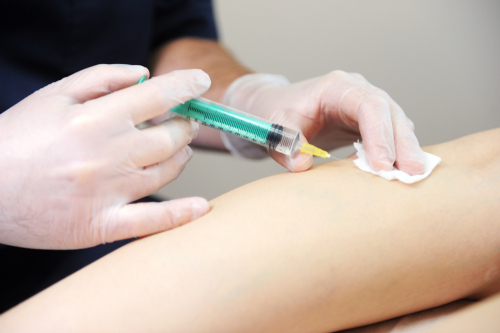
The good news about spider and varicose veins these days is that they are fairly easy to treat. Between sclerotherapy, venous ablation, and microphlebectomy, medical treatments are not only safe, but they are also very affordable.
In contrast, a tattoo is not guaranteed to come out correctly or cover the veins well. Instead of opting for a tattoo, try to reach out to a vein clinic first to ask about your medical options.
Is Laser Treatment an Effective Alternative to Tattooing for Varicose Veins?
When exploring options for addressing varicose veins, laser treatment emerges as a compelling alternative to tattooing. Tattooing may offer a temporary cosmetic cover-up, but it doesn’t address the underlying issue. Here’s why laser treatment stands out as an effective choice:
- Minimally Invasive: Unlike tattooing, which adds ink to conceal veins, laser treatment directly targets and reduces varicose veins without invasive procedures.
- Reduced Pain and Quick Recovery: This procedure is largely pain-free and eliminates the need for significant downtime, allowing you to quickly return to daily activities.
- Long-Term Results: While tattoos may fade or require touch-ups, laser treatment aims to permanently diminish the appearance of varicose veins, providing a more lasting solution.
Additionally, laser technology has advanced significantly, enhancing both the efficacy and safety of the procedure. With options like endovenous laser therapy (EVLT) offered by reputable entities, patients can achieve clearer and healthier-looking skin.
In summary, if treating the root cause of varicose veins is your goal, laser treatment offers a highly effective and reliable alternative compared to simply disguising them with tattoos.
When to Seek Medical Attention After Tattooing Over Varicose Veins
Tattooing over varicose veins can carry certain risks, so it’s important to know when to seek professional medical help. Here’s what to look out for:
- Persistent Bleeding: If bleeding continues for an extended period after the tattooing process, it’s wise to consult a healthcare provider.
- Excessive Swelling or Redness: While some swelling is normal, significant inflammation or redness that doesn’t subside could indicate a problem.
- Signs of Infection: Look for symptoms such as fever, chills, or the presence of pus around the tattoo area. These signs suggest you should promptly seek medical advice.
- Increased Pain: Unusual or worsening pain is a red flag that may require professional evaluation.
- Changes in the Veins: Any noticeable changes in the appearance or condition of the varicose veins themselves should not be ignored.
To ensure proper healing, meticulously follow aftercare guidelines provided by your tattoo artist and schedule follow-up appointments with your healthcare provider. Taking these proactive steps can help minimize complications and ensure your new tattoo heals smoothly.
Bottom Line:
In conclusion, the best and safest option is to not tattoo over a varicose vein to avoid very serious complications and undesirable outcomes.
Instead, it is crucial first to seek a diagnosis from a vein specialist, who can assess the severity of the issue. By addressing the underlying problem and receiving appropriate care to treat varicose veins, you can ensure the health and appearance of your legs while avoiding potential risks and complications associated with tattooing over varicose veins.
Varicose Veins Vs Spider Veins
Wondering what the difference between a varicose vein and a spider vein is? Here’s a quick compare and contrast:
Varicose veins tend to be large, bulging veins that are most commonly found in the legs. Appearance-wise, spider veins are significantly smaller and thinner and appear much closer to the surface of the skin.
Physically, neither condition is usually considered very harmful on its own. Having said that, varicose veins do tend to come with slightly more discomfort – ie, achiness or heaviness in the legs.
How To Get Rid Of Spider Veins
As we mentioned earlier, there are plenty of minimally invasive procedures that can help treat your spider veins. Here are a couple:
- Sclerotherapy : Sclerotherapy is one of the simplest procedures used to get rid of spider veins and varicose veins. During a sclerotherapy treatment, your vein specialist injects a solution directly into the damaged vein. This solution then irritates the lining of your vein and forces it to seal up. Eventually, the tissue is reabsorbed back into the body, and blood simply to a different, healthy vein.
- Venous Ablation: Similar to sclerotherapy, venous ablation also functions by irritating the lining of a vein and forcing it to close. The main difference is that venous ablation utilizes radiofrequency (RF) energy instead of a liquid solution. The good news is that both of these procedures are relatively quick and easy, with little to no downtime. Interested in booking your own sclerotherapy treatment? Simply call or fill out our online form, and someone from our team will reach out to help you schedule a consultation.
Spider Vein Removal
In the case that sclerotherapy and venous ablation don’t work, your vein specialist might recommend vein removal, called a microphlebectomy.During a microphlebectomy, your doctor creates small incisions and carefully removes the damaged veins. This procedure is quick and requires little to no recovery time.
How Do Compression Stockings Help with Varicose Veins?
Compression stockings are an effective, non-invasive way to manage varicose veins. By gently squeezing the leg, these stockings promote better blood circulation. This enhanced blood flow helps prevent blood from pooling in the veins, which is a common issue for those with varicose veins.
Benefits of Compression Stockings:
- Improved Blood Flow: The pressure from the stockings helps push blood back towards the heart, reducing the size and prominence of the veins.
- Reduction in Swelling: By facilitating better circulation, compression stockings can also minimize swelling in the legs and ankles.
- Decreased Discomfort: Many users report relief from symptoms like aching, heaviness, and fatigue after wearing these stockings for an extended period.
Available Styles:
Compression stockings come in various styles and levels of pressure (measured in mmHg), making them suitable for different needs. From knee-highs to full-length tights, there is a solution for every preference and fashion requirement. This diversity ensures that individuals can manage their symptoms without compromising on style.
How They Work:
- Graduated Compression: The design typically emphasizes a tighter fit at the ankles, gradually decreasing in pressure as it moves upward toward the knees or thighs.
- Wear Guidance: For optimal results, it’s important to wear them during the day, removing them at night as needed.
Compression stockings blend functionality with convenience, providing a simple yet effective way to manage varicose veins without medical intervention.
How to Conceal Varicose Veins and Spider Veins on Thighs or Legs
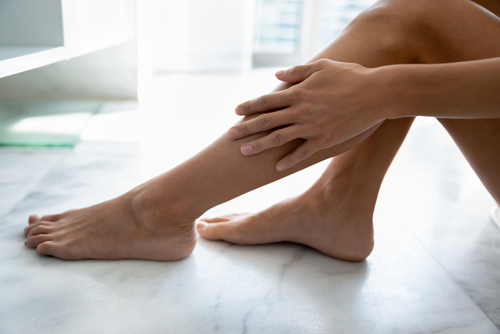
If you are looking for non-surgical ways to conceal spider veins on thighs or other parts of the body, then you may want to consider:
- Body makeup: An effective way to cover up veins and blend them with your skin tone.
- Self-tanner: Helps achieve a more even complexion, reducing the visibility of veins.
- Clothing: Opt for styles that can naturally cover areas with visible veins.
Please keep in mind that without medical intervention, a spider vein is unlikely to disappear on its own.
In addition to these cosmetic solutions, consider incorporating the following methods:
- Regular exercise: Enhances circulation, which can help improve the appearance of your veins over time.
- Compression stockings: These can support your veins and reduce their visibility by improving blood flow.
- Medical treatment: For those seeking a more permanent solution, consult a healthcare professional to explore options like sclerotherapy or laser treatments.
By combining these approaches, you can effectively manage the appearance of spider veins and achieve smoother-looking skin.
How to Prevent Varicose Veins
To prevent varicose and bulging veins, several daily habit changes like these can help:
- Maintaining a healthy lifestyle by engaging in regular exercise, such as walking, swimming, or cycling, promotes healthy blood circulation.
- Avoiding prolonged sitting or standing by taking breaks and moving around throughout the day can also help improve circulation. It’s important to stay hydrated by drinking an adequate amount of water, which helps maintain healthy blood viscosity.
- Wearing comfortable footwear with proper support and avoiding high heels or tight-fitting shoes that restrict blood flow can alleviate strain on the veins.
- Elevating the legs above heart level while resting or sleeping can promote blood flow back to the heart. These simple yet effective strategies can contribute to preventing the development of varicose and bulging veins.
What Is The Cause Of Spider Veins?
The underlying cause of spider veins is the same as that of varicose veins – i.e., malfunctioning valves.
When a valve malfunctions and stops helping blood circulate, the blood often stagnates and begins pooling. As blood pools and begins straining against the walls of its vein, it can cause the vein to turn bluish-purple. These bluish-purple veins are called spider and varicose veins.
Some people are naturally predisposed to spider veins, but it’s not necessarily caused by any one thing that you do. Things such as genetics, gender, and weight can all be contributing factors that impact your risk of developing this condition.
Interested in lowering your risk of developing spider veins? Try to avoid sitting in one place for long periods. Instead, try to get up and walk around or stretch occasionally.
Spider Vein Treatment in Flint, Michigan
Now that you’ve discovered good alternatives for covering up spider veins let’s talk about vein clinics. Here at VeinSolutions Flint, we are happy to provide treatment for spider and varicose veins and other vein conditions.
Interested in learning more about your treatment options? Simply visit our vein treatments page to learn more about sclerotherapy, microphlebectomy, and venous ablation.
To make an appointment with one of our vein specialists, call or fill out our handy online form, and someone from our team will be in touch as soon as possible. Don’t forget that our vein screenings are FREE, so there’s no reason to wait.

